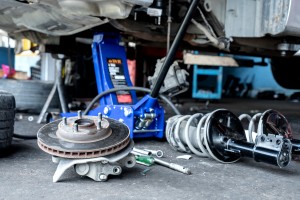Your car’s suspension works hard all year round — absorbing bumps, maintaining tire contact, and ensuring stable handling. But changing seasons bring unique challenges that can affect how well your suspension performs. Temperature swings, moisture, road salt, and varying loads all impact one key component: your suspension springs.
Proper seasonal care helps extend spring life, maintain ride comfort, and prevent costly repairs. Whether you drive through freezing winters or hot, dusty summers, understanding how to prepare your springs for seasonal shifts is essential for safety and performance.
Why Seasonal Suspension Care Matters

Suspension springs operate under constant stress, supporting the vehicle’s weight while enduring countless compression and rebound cycles. Over time, exposure to environmental factors such as corrosion, debris, and temperature changes weakens them.
Winter brings:
-
Moisture, slush, and road salt that cause corrosion and rust.
-
Increased load from snow, passengers, or gear.
-
Stiffer suspension response due to low temperatures.
Summer introduces:
-
Heat expansion, which can alter spring tension.
-
Dust, dirt, and gravel that accelerate wear on mounts and bushings.
-
Increased long-distance driving that tests suspension endurance.
Seasonal maintenance ensures your suspension adapts to these conditions, preserving comfort and stability.
Winter Preparation: Protecting Springs from Cold and Corrosion
When temperatures drop, steel becomes less flexible, and lubricants thicken — both of which can affect how your springs respond. Taking steps before and during winter helps avoid damage and performance loss.
1. Clean and Inspect Thoroughly
Before winter starts, wash the suspension components, including the springs, to remove dirt, grease, and debris. Pay special attention to the lower spring seats and mounting points where moisture can collect.
Inspection checklist:
-
Look for cracks or surface rust on coils.
-
Check for chipped powder coating (a common starting point for corrosion).
-
Examine rubber isolators and bushings for wear or stiffness.
2. Apply Protective Coatings
Rust is the enemy of any steel spring. Applying a light layer of anti-corrosion spray or silicone-based lubricant creates a barrier against road salt and moisture.
Tip: Avoid heavy oil-based products — they attract dust and debris.
3. Adjust Ride Height and Load
If you carry extra winter gear, install snow chains, or tow equipment, the added weight can compress your springs excessively. Adjust ride height if possible (on coilovers or air suspensions), or upgrade to heavier-duty springs for seasonal use.
4. Replace Worn or Sagging Springs
Cold weather worsens fatigue cracks in old springs. If you notice uneven ride height or clunking noises, don’t postpone replacement. It’s best to Buy Springs & Components online to ensure compatibility and corrosion-resistant quality.
Table: Winter Suspension Preparation Guide
| Check / Action | Purpose | Recommended Frequency |
|---|---|---|
| Visual inspection for rust or cracks | Detect early damage | Every 10,000 km or before winter |
| Cleaning with warm water and mild detergent | Remove road salt and debris | Monthly during winter |
| Applying anti-corrosion spray | Prevent rust | Before winter and mid-season |
| Checking ride height | Ensure proper balance | Twice per season |
| Replacing rubber isolators | Maintain spring damping | Every 2 years |
Summer Preparation: Handling Heat and Heavy Loads
As temperatures rise, your suspension faces different challenges. Heat can cause minor expansion in metal components, and long trips or off-road adventures often increase spring strain.
1. Inspect for Fatigue and Sag
Warm weather makes springs more flexible, which may highlight pre-existing wear. Look for uneven ride height or excessive body roll when cornering — these are signs your springs are weakening.
2. Clean and Lubricate
Summer dust and gravel can accumulate around the spring coils and mounts, causing abrasion. Use a gentle water spray or compressed air to clean the springs and apply a thin layer of dry lubricant to moving parts.
3. Prepare for Extra Loads
If you plan summer road trips or carry heavy cargo, consider installing progressive-rate or load-supporting springs to prevent sagging and maintain stability.
Recommended options:
-
Coil springs with variable pitch design (progressive rate).
-
Heavy-duty rear springs for towing and camping.
-
Reinforced bushings for better shock absorption.
4. Monitor Heat-Related Expansion
Prolonged exposure to high temperatures can affect metal fatigue resistance. Avoid overloading the vehicle, and park in shaded areas to minimize thermal stress on suspension components.
Table: Summer Suspension Maintenance Guide
| Action | Goal | Notes |
|---|---|---|
| Inspect spring compression under load | Identify fatigue or imbalance | Check before long trips |
| Clean with air or water | Remove dust and gravel | Every 2–3 weeks |
| Lubricate contact areas | Reduce friction and squeaks | Use dry silicone spray |
| Check spring mounts and isolators | Prevent noise and wear | Replace if cracked |
| Upgrade for towing or heavy loads | Maintain handling and safety | Use rated replacement springs |
General Year-Round Maintenance Tips
Your suspension system works best when maintained consistently. Use these all-season tips to keep your springs in top condition:
-
Inspect every 20,000–30,000 km — or after each extreme season.
-
Avoid mixing spring types (soft front, stiff rear). This disrupts balance.
-
Check wheel alignment after replacing or adjusting springs.
-
Clean undercarriage regularly to prevent buildup of mud, salt, or sand.
-
Replace springs in pairs for even response and safety.
If you’re unsure about spring condition, consult a mechanic or suspension specialist.
Signs Your Springs Need Replacement

Ignoring worn or corroded springs can lead to poor handling, uneven tire wear, and even safety hazards. Watch for these red flags:
-
Noticeable lean to one side
-
Clunking or squeaking noises over bumps
-
Harsh or bouncy ride
-
Visible rust or chipped coating
-
Uneven tire wear patterns
When these signs appear, don’t delay — new springs restore comfort, control, and safety. Explore high-quality options and Buy Springs & Components online for a reliable, long-lasting replacement.
Comparison Table: Winter vs. Summer Suspension Priorities
| Aspect | Winter Focus | Summer Focus |
|---|---|---|
| Main Challenge | Corrosion and stiffness | Heat and overloading |
| Key Maintenance | Cleaning and anti-rust coating | Cleaning and lubrication |
| Spring Adjustment | Increase ride height / stiffness | Balance for load and comfort |
| Materials to Check | Rubber bushings, coatings | Mounts, isolators, spring fatigue |
| Common Replacement Type | Heavy-duty, coated springs | Progressive-rate springs |
Conclusion
Seasonal suspension care isn’t just about comfort — it’s about safety, reliability, and longevity. Preparing your springs for winter prevents rust and fatigue, while summer maintenance keeps them strong and flexible under heat and load.
By inspecting, cleaning, and adjusting your suspension seasonally, you ensure optimal performance and driving confidence no matter the weather.
When replacement or upgrades are due, choose trusted quality and perfect compatibility. You can conveniently Buy Springs & Components online to keep your suspension performing at its best through every season.